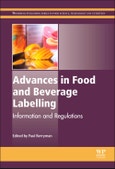- Brings together contributions from industry, trade bodies, government and academia.- Offers timely advice for those concerned with the legal framework for food labelling, with information about the EU Food Information Regulation, as well as the US market.- Reviews issues surrounding nutrition and health claims and GM, ethical and environmental labelling.
Please Note: This is an On Demand product, delivery may take up to 11 working days after payment has been received.
Table of Contents
- List of contributors
- Woodhead Publishing Series in Food Science, Technology and Nutrition
- Preface
- Part One: General trends in regulation and enforcement of food labelling
- 1: The EU food information for consumers regulation
- Abstract
- 1.1 Introduction
- 1.2 General requirements and responsibilities
- 1.3 Mandatory food information
- 1.4 Distance selling
- 1.5 Future trends
- 2: Current regulation of food and beverage labelling in the USA
- Abstract
- 2.1 Introduction
- 2.2 Regulatory oversight of labelling between government bodies
- 2.3 The Federal Food, Drug and Cosmetics (FD&C) Act and The Fair Packaging and Labeling Act
- 2.4 The main labelling requirements according to the Federal Food, Drug and Cosmetics Act
- 2.5 Allergen labelling
- 2.6 Net quantity of contents
- 2.7 Date marking and the uniform open dating regulations
- 2.8 Country of origin
- 2.9 Distance selling
- 2.10 The future of US food labels?
- 2.11 Sources of further information and advice
- 3: Enforcement of food and beverage labelling legislation: enforcement bodies and relevant legislation in the UK
- Abstract
- 3.1 Introduction
- 3.2 The enforcement jigsaw: local government food authorities
- 3.3 Wider responsibilities of local food regulators
- 3.4 National and regional coordination of local authority enforcement
- 3.5 National arrangements for consumer complaints about food and beverage labelling
- 3.6 Outline of relevant legislation relating to food and beverage labelling
- 3.7 Future trends
- 4: Enforcement of food and beverage labelling legislation: enforcement policies and codes in the UK
- Abstract
- 4.1 Introduction
- 4.2 Enforcement policies relating to food and beverage labelling
- 4.3 Local approaches to enforcement
- 4.4 The implications of a failure to meet legal obligations relating to food and beverage labelling
- 4.5 Future trends
- 1: The EU food information for consumers regulation
- Part Two: Trends in labelling relating to nutrition and health
- 5: Nutrition and related labelling of foods and beverages: the case of the USA
- Abstract
- 5.1 Introduction
- 5.2 Nutrition labelling: general requirements
- 5.3 Formats for nutrition labels
- 5.4 Nutrition labelling in restaurants and for alcoholic beverages
- 5.5 Voluntary labelling statements: nutrient content claims
- 5.6 Voluntary labelling statements: health claims
- 5.7 Voluntary labelling statements: organic controls, GM labelling and claims
- 5.8 Voluntary labelling statements: gluten-free and "natural claims
- 5.9 Future trends
- 6: Health claims on food and beverage labels: comparing approaches in the EU and the USA
- Abstract
- 6.1 Introduction
- 6.2 Regulation of health and health-related claims in the EU
- 6.3 Regulation of health and health-related claims in the US
- 6.4 Summary, conclusions and future trends
- 7: Front-of-pack (FOP) labelling of foods and beverages
- Abstract
- 7.1 Introduction
- 7.2 Development of FOP labels
- 7.3 Impact of FOP labelling
- 7.4 Future trends and developments
- Acknowledgements
- 8: Consumer interpretation of nutrition and other information on food and beverage labels
- Abstract
- 8.1 Introduction
- 8.2 Consumer perception and use of front-of-package information
- 8.3 Consumers ability and motivation to process health-related information from food packages
- 8.4 Consumer understanding of health-related information
- 8.5 Future trends
- 5: Nutrition and related labelling of foods and beverages: the case of the USA
- Part Three: Trends in labelling relating to other aspects of food quality
- 9: Ethical and environmental labelling of foods and beverages
- Abstract
- 9.1 Introduction
- 9.2 Defining ethical labelling
- 9.3 Defining environmental labelling
- 9.4 Control of labelling schemes
- 9.5 The motivation behind consumer purchasing choices
- 9.6 A review of global environmental and ethical schemes
- 9.7 A review of industry labels and schemes
- 9.8 Economics of the main labelling schemes
- 9.9 Summary
- 9.10 Future trends
- 10: Labelling of genetically modified (GM) ingredients in foods and beverages
- Abstract
- 10.1 Introduction
- 10.2 Genetic modification (GM) in food production: an overview
- 10.3 European approval processes
- 10.4 European regulation of GM food and feed
- 10.5 GM labelling: principles and regulatory requirements
- 10.6 Consumer expectations of GM labelling
- 10.7 Future trends
- Websites
- 11: Smart labelling of foods and beverages
- Abstract
- 11.1 Introduction
- 11.2 Labelling to detect changes in temperature
- 11.3 Labelling to monitor freshness
- 11.4 Labelling to detect changes in oxygen concentration
- 11.5 Labelling to detect changes in carbon dioxide concentration
- 11.6 The use of electronic technology to develop smart labelling
- 11.7 Conclusions and future trends
- 12: Labelling relating to natural ingredients and additives
- Abstract
- 12.1 Introduction
- 12.2 Clean label definitions
- 12.3 Clean label and the consumer
- 12.4 Clean label/Natural/Free from
- 12.5 Clean label challenges
- 12.6 Clean label ingredients
- 12.7 Future trends
- 9: Ethical and environmental labelling of foods and beverages
- Index








